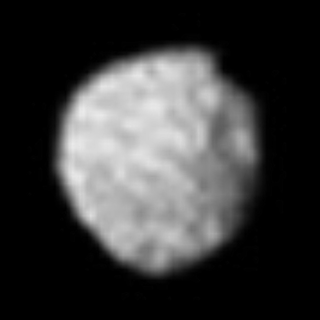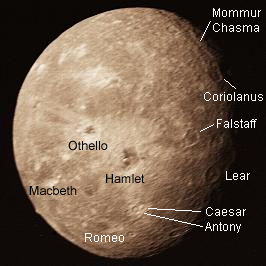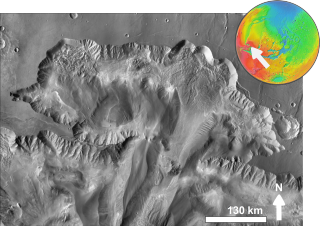
Jet Propulsion Laboratory (JPL) is a federally funded research and development center in Pasadena, California, United States. Founded in 1936 by Caltech researchers, the laboratory is now owned and sponsored by the National Aeronautics and Space Administration (NASA) and administrated and managed by the California Institute of Technology.

Mariner 9 was a robotic spacecraft that contributed greatly to the exploration of Mars and was part of the NASA Mariner program. Mariner 9 was launched toward Mars on May 30, 1971, from LC-36B at Cape Canaveral Air Force Station, Florida, and reached the planet on November 14 of the same year, becoming the first spacecraft to orbit another planet – only narrowly beating the Soviet probes Mars 2 and Mars 3, which both arrived at Mars only weeks later.

Puck is an inner moon of Uranus. It was discovered in December 1985 by the Voyager 2 spacecraft. The name Puck follows the convention of naming Uranus's moons after characters from Shakespeare. The orbit of Puck lies between the rings of Uranus and the first of Uranus's large moons, Miranda. Puck is approximately spherical in shape and has diameter of about 162 km. It has a dark, heavily cratered surface, which shows spectral signs of water ice.

Eugene Merle Shoemaker was an American geologist. He co-discovered Comet Shoemaker–Levy 9 with his wife Carolyn S. Shoemaker and David H. Levy. This comet hit Jupiter in July 1994: the impact was televised around the world. Shoemaker also studied terrestrial craters, such as Barringer Meteor Crater in Arizona, and along with Edward Chao provided the first conclusive evidence of its origin as an impact crater. He was also the first director of the United States Geological Survey's Astrogeology Research Program.

Harold (Hal) Masursky was an American astrogeologist.

Planetary geology, alternatively known as astrogeology or exogeology, is a planetary science discipline concerned with the geology of celestial bodies such as planets and their moons, asteroids, comets, and meteorites. Although the geo- prefix typically indicates topics of or relating to Earth, planetary geology is named as such for historical and convenience reasons; due to the types of investigations involved, it is closely linked with Earth-based geology. These investigations are centered around the composition, structure, processes, and history of a celestial body.

Carolyn C. Porco is an American planetary scientist who explores the outer Solar System, beginning with her imaging work on the Voyager missions to Jupiter, Saturn, Uranus and Neptune in the 1980s. She led the imaging science team on the Cassini mission in orbit around Saturn. She is an expert on planetary rings and the Saturnian moon, Enceladus.

The Astrogeology Science Center is the entity within the United States Geological Survey concerned with the study of planetary geology and planetary cartography. It is housed in the Shoemaker Building in Flagstaff, Arizona. The Center was established in 1963 by Eugene Merle Shoemaker to provide lunar geologic mapping and to assist in training astronauts destined for the Moon as part of the Apollo program.
Michael C. Malin is an American astronomer, space scientist, and CEO of Malin Space Science Systems. His cameras have been important scientific instruments in the exploration of Mars.

The exploration of Uranus has, to date, been through telescopes and a lone probe by NASA's Voyager 2 spacecraft, which made its closest approach to Uranus on January 24, 1986. Voyager 2 discovered 10 moons, studied the planet's cold atmosphere, and examined its ring system, discovering two new rings. It also imaged Uranus' five large moons, revealing that their surfaces are covered with impact craters and canyons.

Kuiper is a moderate-size crater with a central peak cluster located at 11.35°S 31.23°W on Mercury. It is 62 kilometers in diameter and was named after Dutch-American astronomer Gerard Kuiper in 1976. It is one of only 2 Mercurian craters which are named not after artists, and one of very few cases when the same name is used for 3 craters. Gerard Kuiper, being a leader of American planetary science, died shortly before the first images of Mercurian surface were made.

Mommur Chasma is the largest 'canyon' on the known part of the surface of Uranus' moon Oberon. This feature probably formed during crustal extension at the early stages of moon's evolution, when the interior of Oberon expanded and its ice crust cracked as a result. The canyon is an example of graben or scarp produced by normal fault(s). The chasma was first imaged by Voyager 2 spacecraft in January 1986.

Ophir Chasma is a canyon in the Coprates quadrangle of Mars at 4° south latitude and 72.5° west longitude. It is about 317 km long and was named after Ophir, a land mentioned in the Bible. In the Bible it was the land which King Solomon sent an expedition that returned with gold. It is a classical albedo feature name.

Charles Kohlhase worked for forty years at NASA/JPL leading the design of several robotic deep-space planetary missions. He is also an author, game developer and lecturer.

Rousillon Rupes is a scarp on the surface of the Uranian moon Titania named after "Bertram, count of Rousillon" in William Shakespeare's comedy All's Well That Ends Well. The 402 km long feature is a normal fault situated near the equator and running perpendicular to it. The scarp cuts impact craters, which probably means that it was formed at a relatively late stage of moon's evolution, when the interior of Titania expanded and its ice crust cracked as a result. Rousillon Rupes has only few crater superimposed on it, which also implies its relatively young age. The scarp was first imaged by Voyager 2 spacecraft in January 1986.

The Kachina Chasmata are the longest canyon or system of canyons on the surface of the Uranian moon Ariel. The name comes from a spirit in Hopi mythology. The 622 km long and 50 km wide chasmata arise from a system of normal faults running from the north-west to south-east. The faults bound down-dropped crustal blocks forming structures called graben. The canyons cut the cratered terrain, which means that they were formed at a relatively late stage of the moon's evolution, when the interior of Ariel expanded and its ice crust cracked as a result. The floor of the canyons is not visible on the images obtained by the Voyager 2 spacecraft in January 1986; thus, whether it is covered by smooth plains like the floors of other Arielian graben is currently unknown.

Hesperia Planum is a broad lava plain in the southern highlands of the planet Mars. The plain is notable for its moderate number of impact craters and abundant wrinkle ridges. It is also the location of the ancient volcano Tyrrhena Mons. The Hesperian time period on Mars is named after Hesperia Planum.

Emily Stewart Lakdawalla is an American planetary geologist and former Senior Editor of The Planetary Society, contributing as both a science writer and a blogger. She has also worked as a teacher and as an environmental consultant. She has performed research work in geology, Mars topography, and science communication and education. Lakdawalla is a science advocate on various social media platforms, interacting with space professionals and enthusiasts on Facebook, Google+ and Twitter. She has appeared on such media outlets as NPR, BBC and BBC America.

Mayda Insula is an island in the Kraken Mare, a body of liquid composed primarily of methane, on Saturn's largest moon Titan. Mayda Insula is the first island (insula) to be named on a planet or moon other than Earth.


















